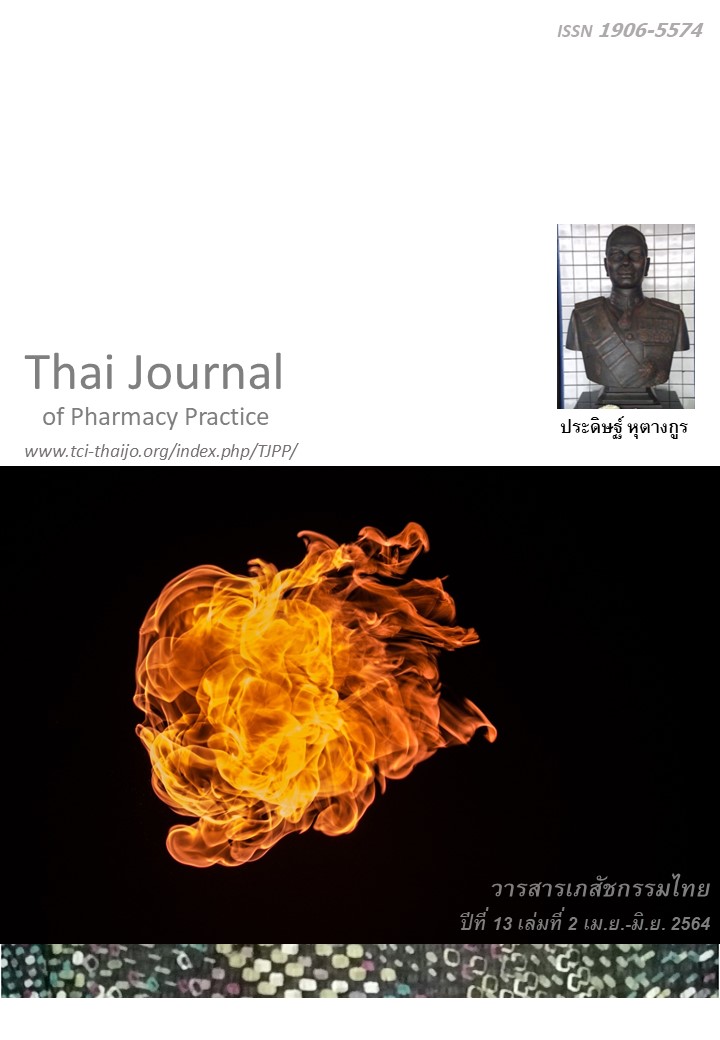การทดสอบแบบวัดความแตกฉานด้านสุขภาพของคนไทยที่อิงความสามารถในการใช้ฉลากโภชนาการ และความแตกฉานด้านสุขภาพของผู้รับบริการจากโรงพยาบาลของรัฐในจังหวัดนครศรีธรรมราช
Main Article Content
บทคัดย่อ
วัตถุประสงค์: เพื่อทดสอบความตรงและความเที่ยงของแบบวัดความแตกฉานด้านสุขภาพ (health literacy: HL) ของคนไทยที่อิงการวัดความสามารถในการใช้ฉลากโภชนาการ (Thai Health Literacy Assessment Instrument: Nutrition Label; THLA-N8) ตลอดจนหาเกณฑ์คะแนน (cut-off) สำหรับใช้แปลผลระดับ HL ที่วัดโดย THLA-N8 และเพื่อประเมิน HL ของผู้รับบริการแผนกผู้ป่วยนอกจากโรงพยาบาลในสังกัดกระทรวงสาธารณสุขในจังหวัดนครศรีธรรมราช วิธีการ: การศึกษาทดสอบความตรงและความเที่ยงของ THLA-N8 ในผู้รับบริการ 1,003 รายจากโรงพยาบาลชุมชน 1 แห่ง จำนวน 503 รายและโรงพยาบาลทั่วไป 1 แห่ง จำนวน 500 ราย การศึกษาทดสอบความตรงโดยเปรียบเทียบค่าเฉลี่ย THLA-N8 ของผู้ที่มีระดับการศึกษาแตกต่างกัน และการหาความสัมพันธ์ระหว่าง THLA-N8 กับความสามารถในการเข้าใจเอกสารสุขภาพและคำถามที่บ่งบอก HL ที่นำมาจากแบบวัดทักษะที่บ่งบอก HL สำหรับคนไทยหรือ Thai Health Literacy Skills Instrument (THLA-S) การศึกษาใช้การวิเคราะห์โค้ง receiver operating characteristics (ROC) ในการหาเกณฑ์แปลผลคะแนน โดยใช้คะแนนความสามารถในการเข้าใจเอกสารสุขภาพเป็นตัววัดมาตรฐานที่ 1 (gold standard 1: GS1) และใช้ผลรวมคะแนนความสามารถในการเข้าใจเอกสารสุขภาพและคะแนนคำถาม 4 ข้อจาก THLA-S เป็นตัววัดมาตรฐานที่ 2 (GS2) การประเมิน HL ของผู้รับบริการทำในตัวอย่าง 1,100 รายที่มารับบริการจากแผนกผู้ป่วยนอกของโรงพยาบาลในสังกัดกระทรวงสาธารณสุขทั้ง 23 แห่งในจังหวัดนครศรีธรรมราช ผลการวิจัย: THLA-N8 มีความเที่ยงของ Cronbach 0.71 แบบวัดมีความตรงโดยผู้ที่มีระดับการศึกษาที่สูงกว่า มีคะแนน THLA-N8 มากกว่าผู้ที่ระดับการศึกษาที่ต่ำกว่า (P<0.001) THLA-N8 มีค่าสหสัมพันธ์ทางบวกอย่างมีนัยสำคัญทางสถิติกับตัวชี้วัด HL 2 ตัว คือความเข้าใจเอกสารสุขภาพและคำถาม 4 ข้อซึ่งเป็นส่วนหนึ่งของ THLA-S (r=0.52 และ 0.47 ตามลำดับ) ผลลัพธ์จากการวิเคราะห์โค้ง ROC พบว่า แบบวัด THLA-N8 มีพื้นที่ใต้โค้ง 0.76 และ 0.82 เมื่อใช้ GS1 และ GS2 เป็นตัววัดมาตรฐานตามลำดับ ซึ่งบ่งชี้ว่า แบบวัดสามารถคัดแยกผู้ที่มี HL เพียงพอหรือไม่เพียงพอออกจากกันได้ดี คะแนน THLA-N8 น้อยกว่าหรือเท่ากับ 4.83 บ่งบอกระดับ HL ที่ไม่เพียงพอ แบบวัดมีความไว 0.75 และ 0.80 มีความจำเพาะ 0.67 และ 0.74 เมื่อใช้ GS1 และ GS2 เป็นตัววัดมาตรฐานตามลำดับ เมื่อใช้จุดตัดคะแนน THLA-N8 ที่ 4.83 คัดกรองผู้รับบริการ พบผู้รับบริการในภาพรวมมี HL ไม่เพียงพอร้อยละ 51.90 ผู้ที่มีการศึกษาในระดับประถมศึกษาถึงมัธยมศึกษาตอนปลาย/ประกาศนียบัตรวิชาชีพชั้นต้นในทุกกลุ่มอายุ (20 ถึง 80 ปี) มี HL ไม่เพียงพอร้อยละ 51.72 ถึง 100.00 ผู้ที่มีการศึกษาในระดับประกาศนียบัตรวิชาชีพชั้นสูง ปริญญาตรีหรือสูงกว่ามี HL ไม่เพียงพอในทุกกลุ่มอายุ (20 ถึง 80 ปี) ร้อยละ 36.08 – 49.21 สรุป: THLA-N8 มีความตรง ความเที่ยง ความไว และความจำเพาะอยู่ในระดับที่น่าพอใจใกล้เคียงกับงานวิจัยในอดีต THLA-N8 สามารถใช้คัดกรองผู้รับบริการในระบบสุขภาพได้ ผู้มีการศึกษาในระดับมัธยมศึกษาตอนปลายและประกาศนียบัตรวิชาชีพชั้นต้นหรือต่ำกว่าในทุกกลุ่มอายุมี HL ไม่เพียงพอประมาณร้อยละ 50.00 หรือมากกว่า ปัญหาพบมากขึ้นในกลุ่มผู้สูงอายุ
Article Details
ผลการวิจัยและความคิดเห็นที่ปรากฏในบทความถือเป็นความคิดเห็นและอยู่ในความรับผิดชอบของผู้นิพนธ์ มิใช่ความเห็นหรือความรับผิดชอบของกองบรรณาธิการ หรือคณะเภสัชศาสตร์ มหาวิทยาลัยสงขลานครินทร์ ทั้งนี้ไม่รวมความผิดพลาดอันเกิดจากการพิมพ์ บทความที่ได้รับการเผยแพร่โดยวารสารเภสัชกรรมไทยถือเป็นสิทธิ์ของวารสารฯ
เอกสารอ้างอิง
Sørensen K, Van den Broucke S, Fullam J, Doyle G, Pelikan J, Slonska Z, Brand H. Health literacy and public health: a systematic review and integration of definitions and models. BMC Public Health 2012; 12:80. doi: 10.1186/1471-2458-12-80.
Berkman ND, Sheridan SL, Donahue KE, Halpern DJ, Viera A, Crotty K, et al. Health literacy interven tions and outcomes: an updated systematic review. Evid Rep Technol Assess 2011; 199:1-941.
Kanj M, Mitic W. Health literacy and health promotion definitions, concepts and examples in the Eastern Mediterranean region [online]. 2009 [cited Nov 12, 2017]. Available from: www.dors.it/documentazione /testo/201409/02_2009_OMS%20Nairobi_Health%20Literacy.pdf
Kutner M, Greenberg E, Jin Y, Paulsec C. U.S. Department of Education, National Center for Education Statistics. The health of America’s adults: Result from the 2003 National Assessment of Adult Literacy (NCES 2006-483). Washington DC; 2006.
Sørensen K, Pelikan JM, Röthlin F, Ganahl K, Slonska Z, Doyle G, et al. Health literacy in Europe: comparative result of the European health literacy survey (HLS-EU). Eur J public health 2015; 1053-58.
Nguyen TH, Paasche-Orlow MK, Kim MT, Han HR, Chan KS. Modern measurement approach to health
literacy scale development and refinement: over view, current use, and next step. J Health Commun.
; 20: S112-5.
Duell P, Wright D, Renzaho AMN, Bhattacharya D. Optimal health literacy measurement for the clinical
setting: A systematic review. Patient Educ Couns 2015; 98: 1295-307.
Na Pattalung P. Development of a Health Literacy Screener for Thais Based on the Approach of the Newest Vital Sign [master thesis]. Songkhla: Prince of Songkla University; 2018.
Chew LD, Bradley KA, Boyko EJ, Brief questions to identify patients with inadequate health literacy.
Fam Med. 2004; 36: 588-94.
Faul GF, Erdfelder E, Buchner A and Lang AG. Statistical power analyses using G*Power 3:1: tests for correlation and regression analyses. Behav Res Methods 2009; 41: 1149-60.
Warotamakul P. Development of a measure of health literacy skills for Thai based on the approach of the Health Literacy Skill Instrument [master thesis]. Songkhla: Prince of Songkla University; 2019.
Howell DC. Statistical methods for psychology. Belmont, CA: Thomson Wadsworth, 2010.
Youden WJ. Index for rating diagnostic tests. Cancer 1950; 3:32-5.
Swets JA. Measuring the accuracy of diagnostic systems. Science 1988; 240: 1285-93.
Jaeschke R, Guyatt GH, Sackett DL. Users' guides to the medical literature. III. How to use an article about a diagnostic test. A. Are the results of the study valid? JAMA 1994; 271:389-91.
Cochrane WG, Sampling techniques. 3rd 3d. New York: John Wiley & Sons; 1977.
Ministry of Public Health. Outpatient service utilization rate in 23 hospitals in Nakhon Si Tham marat Provinces [online]. 2016 [cited Nov 12, 2017]. Available from: hdcservice.moph.go.th/hdc/reports /report.php?source=pformated/format1.php&cat_id=9d8c311d6336373d40437c4423508cad&id=4b35d96e225bf34a16774b13705250f4.
Nunnally JC, Bernstein IH. Psychometric theory. New York: McGraw-Hill Education; 1994.
Weiss BD, Mays MZ, Martz W, Casto KM, DeWalt DA, Pignone MP, et al. Quick assessment of lite racy in primary care: The Newest Vital Sign. Ann Fam Med 2005; 3: 514-22.
Kline P. A Handbook of test of construction. London: Methuen; 1986:143.
Jindawong B. Development of health literacy screening tools for patients at Srinagarind Hospital, Khon Kaen, Thailand [master thesis]. Khon Khaen: Khon Khaen University; 2013.
Intarakamhang U. Health literacy: measurement and development [online]. 2017 [cited Mar 16, 2018]. Available from: bsris.swu.ac.th/upload/268335.pdf.
Phantong W. Development of the Thai Health Literacy Assessment using Word List (THLA-W) [minor thesis]. Songkhla: Prince of Songkla Univer- sity; 2016.
Janchooto P. Development of the Thai Health Literacy Assessment Using Word List with Extended Questions to Test Comprehension (THLA -W+): Testing in Sadao Hospital [minor thesis]. Songkhla: Prince of Songkla University; 2017.
Daraman N. Testing of the Thai Health Literacy Assessment Using Word List with Extended Questions to Test Comprehension: Testing in Muslim Patients [master thesis]. Songkhla: Prince of Songkla University; 2019.
Hayibueraheng H. Development of the Thai Health Literacy Assessment Using Word List with Extended Questions to Test Comprehension (THLA -W+): Testing in Community [master thesis]. Songkhla: Prince of Songkla University; 2019.
Department of Provincial Administration, Ministry of Interior.Population in Nakorn Si Thammarat pro vince [online]. 2010 [cited Sep 30, 2019]. Available from: service.nso.go.th/nso/nsopublish/districtList/ page1.htm.


